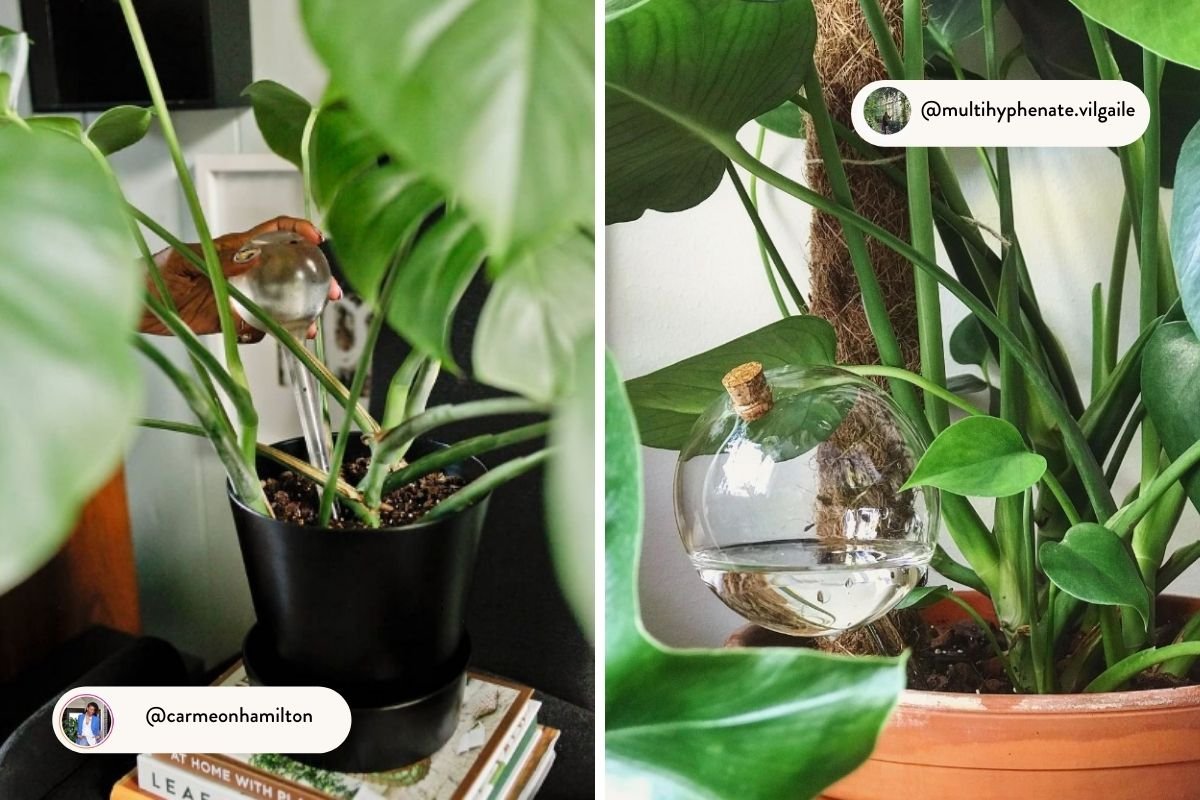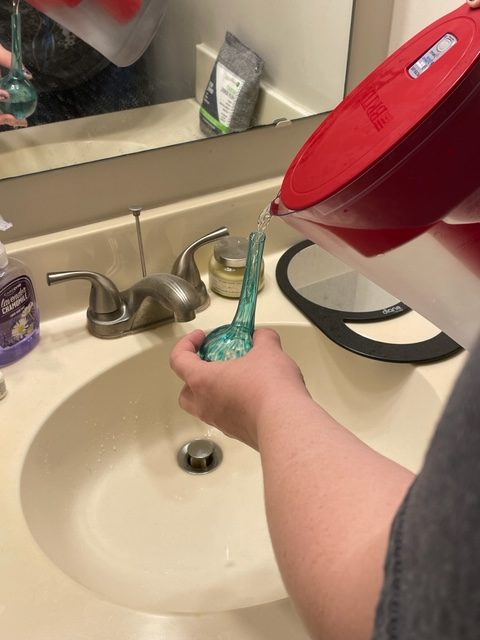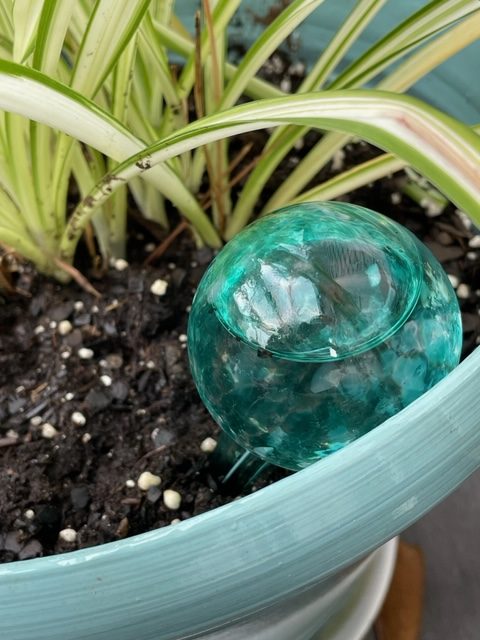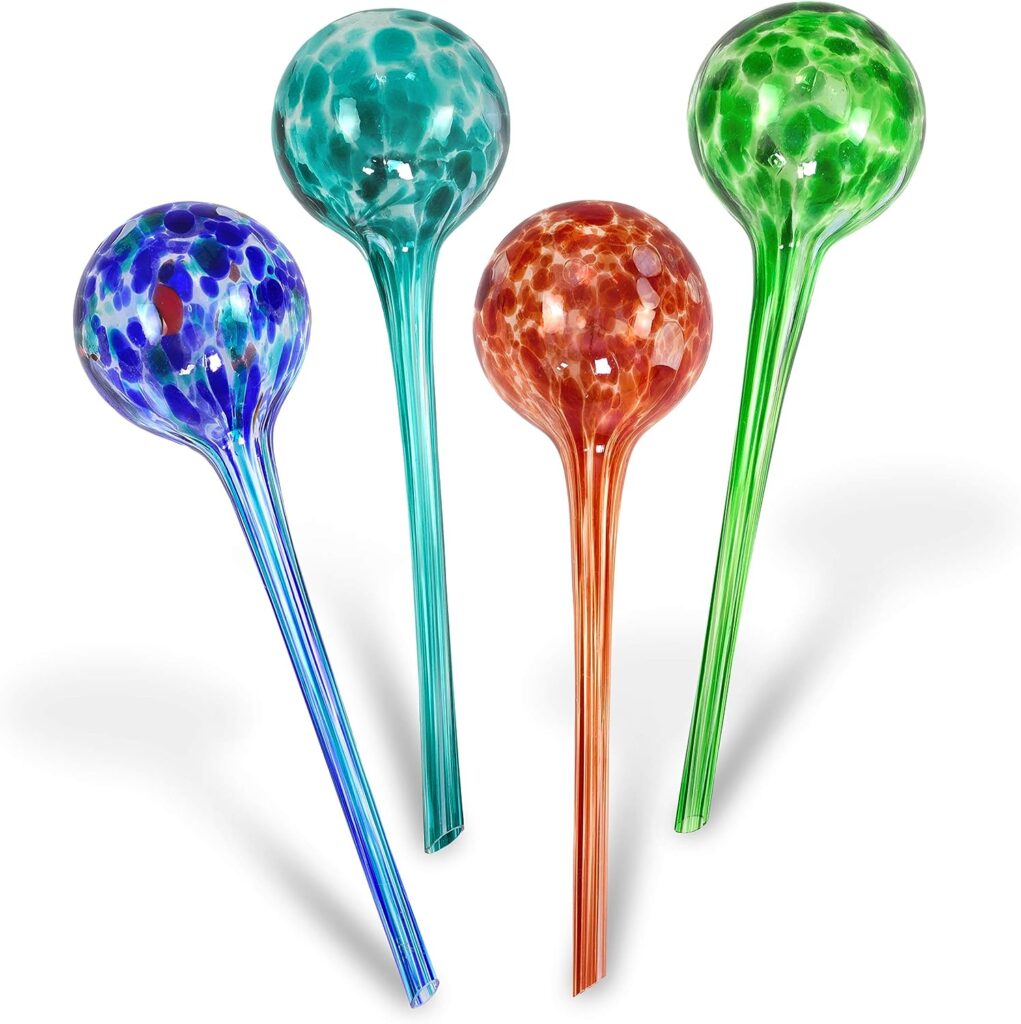The strange objects known as watering globes, aqua globes, or watering spikes have come into prominence in recent years, advertised as devices that can keep your potted plants watered for up to two weeks without much effort on your part.
Using a watering globe is a great, low maintenance alternative to using a watering can for some houseplants! But do these beautiful glass plant watering orbs really work?
Finding the best watering globes for plants means finding something that actually, uh, waters your plants.
Many people find watering globes a good solution when they are away on vacation, but I’m not convinced that they’re necessary. So I looked into it and then I ordered some to test for myself. Read on to find everything you need to know about these plant accessories.
What exactly are plant watering globes?
Watering globes, aqua globes, self-watering globes, or watering spikes as they are sometimes called, are pretty blown glass bulbs with long, thin necks and a small opening at the bottom.
They also come in plastic or metal varieties, and can even be a DIY project using a plastic water bottle or wine glass! (I’ve seen the videos, they’re quite impressive.)
The manufacturers claim that by filling these globes with water and sticking them into the soil of your plants, it will water the plants for you. These aqua globes are best used indoors. and can be a great addition to your indoor garden when used correctly.
Plus, they add beautiful flair to your houseplants.
How watering globes work (and do they work?)
These beautiful glass globes do serve a purpose in plant care, but the advertisements can be misleading. Many companies claim these will keep your plants watered with a trickle of water for up to a week or two. But depending on factors like the soil and type/size of the plant, the water may not last nearly that long…
… or may last longer!
Also, frequent cleaning and filling is necessary. While these devices are advertised as a low-effort way to water plants, it actually requires careful planning and a bit of effort to be used correctly.
But if you understand how they work and how to take care of your plants, then they can be a helpful addition to your regular plant watering schedule.
The process by which your plant gets watered with the watering globe is simple: as water trickles out of the stem, it creates a weak vacuum inside the globe that slows down the release of water.
When the soil dries out around the neck of the globe, air is able to enter the globe and displace a small amount of water, until the equilibrium is restored. This means that the moisture in the plant’s soil prevents air from entering the globe until it dries out again.
This process limits the rate at which the bulb empties, so it only releases water when the surrounding soil is dry.
So which one is best? That’s what I’m trying to find out. So I bought a few of them, along with a moisture meter, and I’m going to test these bad boys to see if they’re worth the hype.
How to use watering globes
Using a watering globe is simple. To insert the watering globe, you do not want to simply push it into the soil on its own. Debris can quickly clog the opening and no water will be able to escape. So to prevent this from happening, there are a few steps to using your watering globe:
- Carefully fill the globe with water by pouring the water into the slender opening until the globe is full
- Start by poking a pencil or other slender object (such as a large knitting needle or dowel rod) about the same size as your globe’s stem into the soil to create a small hole. You may want to install your self watering globe at a slight angle tilted toward the plant, but play around with this, as water will escape faster if angled too much.
- After your hole is established, invert the watering globe and place the neck into the hole.
A few helpful notes:
- PRO TIP: A little water will escape at first, until the vacuum process fixes itself. It is best to water your plant before inserting the bulb to ensure it doesn’t empty water too fast.
- PRO TIP: If it does not stand upright, do not push on it! This will clog the tube. Remove the globe and make the hole deeper with your pencil or tool of choice, then try again.
- PRO TIP: If placed in the sun, then it is more likely to grow algae. Keep it out of sunlight to slow down growth of algae or bacteria.

How to fill watering globes
Watering globes aren’t the easiest things to fill, as the openings are small and narrow. It is easier to use a measuring cup or other cup with a spout on it to carefully pour the water in until the globes are about 3/4 full. Simply fill a measuring cup with filtered water (always filter your water from the kitchen sink or other water source!) and then proceed to pour it into the bulb.

How to clean your watering globe
A downside of using the watering globes is they can get dirty and will need periodic cleaning. The neck of the globe can become clogged with soil or debris and the globe portion can grow mold or algae due to the damp environment.
You definitely do not want these things getting into your plants, so it is best to clean it often to prevent mold growths. This may appear as a “cloudy” look inside the glass.
There are a few ways to clean your globes, such as detergent and warm, not hot, water. Here’s some other ways to clean your aqua globes, you can choose the method that is easiest for you:
- Pour a sprinkle of baking soda into the bulb, followed by lemon juice or white vinegar. Swirl the mixture around the bulb portion, then drain and rinse it out well.
- Pour a small amount of fine sand into the bulb and add water until the globe is about 1/4 full. Cover the end of the stem with your thumb and shake the globe until clean. Drain and rinse well.
- Pour a small amount of bleach into the globe, then pour in water until the globe is filled. Prop the bulb stem side up in a glass or mug, and let it sit for ten minutes. Drain and rinse well.
- If the stem is clogged, a pipe cleaner or straw cleaning brush can be used to loosen the soil, then flush with water to remove it.
After cleaning, wipe the watering globe with a clean, dry cloth. Then you can continue using it as normal until time to clean again. The key thing to remember is that these watering globes (especially the glass ones) are fragile and should be handled carefully to avoid breaking. Make sure the water you are using is just warm and not too hot, as this could create thermal shock and cause the glass to crack and break!
Final verdict: The best watering globes for plants
So which ones are the best? The Blazin’ Bison brand seems most reliable and has been around for the longest.
To test the hype about the watering globes, and see if they really worked, I purchased Blazin’ Bison’s Indoor Plant Watering Globes. They had several styles and sizes, so I purchased a small 4 piece set. They are gorgeous globes, each one a beautiful color and are hand-blown glass. They were very aesthetically pleasing in my potted plant. The product information said it would keep a plant’s soil moist for about two weeks.
Pros
- Easy to use
- Cute and quirky
- Great customer support
Cons
- The water drained too quickly (overnight)
- They did not last for more than a day
- Can break if you don’t do it exactly right
- They’re really hard to fill up
- They’re really hard to clean
The trick is in positioning it correctly so that the water doesn’t come spilling out at once. If inserted straight up and down (instead of at an angle, as the brand recommends), then this slows the air from entering too quickly and pushing the water out.

You may be wondering…
How often do you have to refill a watering globe?
Most water and aqua globes on the market boast that they will water your plants for two weeks. As mentioned, this can be misleading and several factors slow or speed up that time frame. Here are some factors to consider if you want to use watering globes for your plants:
- Size – Watering globes are sold in various sizes, from mini globes to large. Depending on the size of your globe, it will keep the plant watered for a few days or about two weeks. However, using a watering globe that is too big can run the risk of overwatering your plant. You will want to match the aqua globe to the size of your plant, for example, using a bigger size for large plants.
- Soil type – It is important to consider the soil type of your plant. Most commercial potting soils and mixes contain peat moss or coconut fibers that increase soil moisture duration. This keeps your plant damp for longer. In this case, the aqua globe will not release water until the surrounding soil is dry, so your watering globe may not empty as fast. If you use fast-draining soil, water may escape quickly and empty the bulb faster.
- Season – Using watering globes for outdoor plants is not recommended, however, the season (even inside) can affect your self watering globe. For example, a plant placed in a window where it gets a lot of sun can evaporate the water faster. A word of caution, having an aqua globe in direct sun is not a good idea, as it can create a “hot spot” and cause heat damage to your plants. (think: magnifying glass + sun)
Can you overwater with water globes?
The answer to this question is yes if you aren’t careful. For example, all potted plants are not good candidates for watering globes. If you want to use a self watering globe with your succulents, it could lead to overwatering.
Succulents like to dry out between watering, and the constant supply of water coming in, could leave them in bad shape. For these types of plants, water your plants before you leave, and they should be fine until you return, no watering globes are required.
The self watering bulbs are good for keeping the soil moist, so be careful when considering which plants could benefit from using self-watering globes.
Which indoor plants do watering globes work best with?
As mentioned, many plants may benefit from more water. These plants typically like a steady supply of water and can quickly wilt if they get too dry. With these plants, aqua globes may be helpful to keep the plant’s soil moist.
Normally, self-watering globes are not recommended for outdoor plants due to their fragility, so you would want to limit them to houseplants only.
A good brand of watering globes to try is Blazin’ Bison’s line of self-watering bulbs, they come in various sizes and styles and have glowing reviews on Amazon.
Some types of plants that are a good fit for the self-watering globe are listed below:
- Calathea: These gorgeous tropical plants enjoy high humidity and consistently moist soil. Because rattlesnake plants also enjoy a regular dose of Calathea fertilizer, self watering globes help to deliver the nutrients and moisture this plant needs to thrive.
- Pothos: A pothos is a perfect candidate for the water globe. They like drying out a bit between watering, which gives the watering globe enough time to release enough water on its regular schedule to keep your pothos adequately watered.
- Spider plant: My personal favorite, the spider plant, can benefit from using a watering globe. You should allow the soil to dry before watering the spider plant, which is what the water globe is designed to do. It will keep the plant watered when necessary.
More about watering plants
- How Often To Water Dracaena (Including Snake Plants)
- How to Use Leca for Plants: Step-by-Step Guide with Pictures
- How To Save An Overwatered Snake Plant
- How Often To Water Pothos Plants (And When To Cut Back)
- How Often To Water Monstera Plants
- 11 Plants That Don’t Need Drainage And How To Care For Them
- Save Your Overwatered Monstera In 4 Steps (And How Not To Do It Again)





I don’t understand how doesn’t all the water just instantly soak in to the soil, and then drip out the bottom of the pot?
This is what the article says “The process by which your plant gets watered with the watering globe is simple: as water trickles out of the stem, it creates a weak vacuum inside the globe that slows down the release of water. “
The article explains it. “The process by which your plant gets watered with the watering globe is simple: as water trickles out of the stem, it creates a weak vacuum inside the globe that slows down the release of water. “
A plant and animal lover!
I’d like to which plants you recommend for apartment living that are safe for pets.
Hey Elaine 😊
Great to hear from you.
Thankfully, there is quite a wide range of houseplants that are safe for both cats and dogs. If you are into palms, the Date Palm, Banana Palms and Areca Palm are all safe for pets.
Some pet-safe tropical or subtropical species include Calatheas, Polka Dot Plant, Peperomia varieties, orchids, and Bromeliad species.
Or if you’re a succulent lover, the Zebra Haworthia, Blue Echeveria, Burro’s Tail, and Moonstones are all non-toxic. Just be careful, there are certain succulents that are toxic to both cats and dogs.
There are literally a ton more houseplants that aren’t toxic, though. The hard part is, toxicity is species specific. So, although a genus may contain some non-toxic species, another species that falls under the same genus could be toxic.
For this reason, my best advice would be to grab the botanical names of the plants you have your eye on and use Google Search to find out more information.
One more factor to take into consideration: some plants are toxic to dogs while not to cats, and vice versa. When choosing houseplants, it’s a good idea to keep this in mind as well.
I hope this helps!